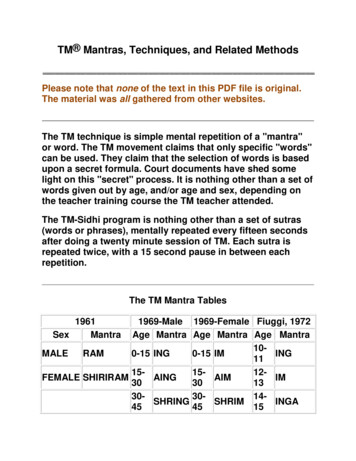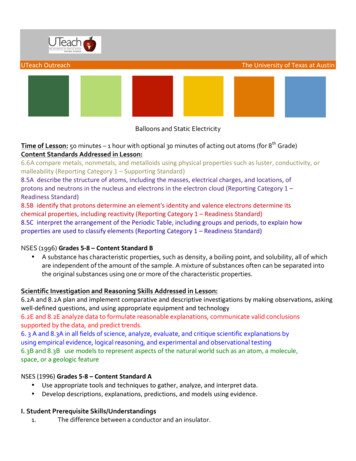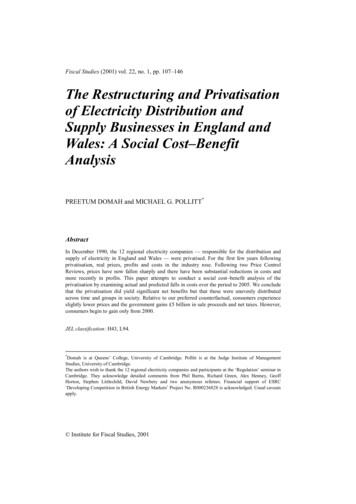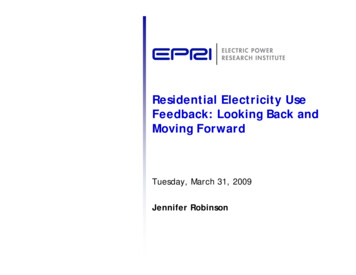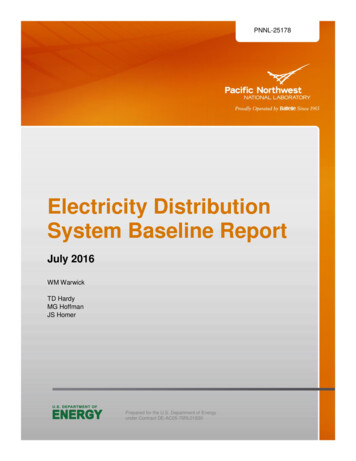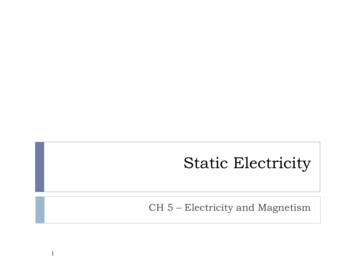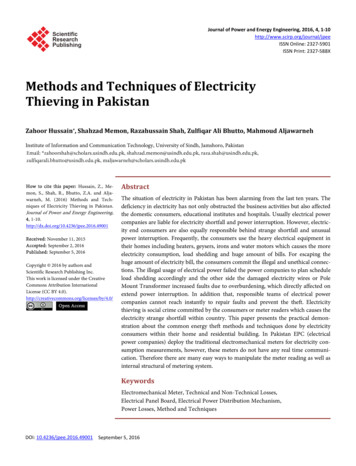
Transcription
Journal of Power and Energy Engineering, 2016, 4, 1-10http://www.scirp.org/journal/jpeeISSN Online: 2327-5901ISSN Print: 2327-588XMethods and Techniques of ElectricityThieving in PakistanZahoor Hussain*, Shahzad Memon, Razahussain Shah, Zulfiqar Ali Bhutto, Mahmoud AljawarnehInstitute of Information and Communication Technology, University of Sindh, Jamshoro, PakistanHow to cite this paper: Hussain, Z., Memon, S., Shah, R., Bhutto, Z.A. and Aljawarneh, M. (2016) Methods and Techniques of Electricity Thieving in Pakistan.Journal of Power and Energy Engineering,4, ived: November 11, 2015Accepted: September 2, 2016Published: September 5, 2016Copyright 2016 by authors andScientific Research Publishing Inc.This work is licensed under the CreativeCommons Attribution InternationalLicense (CC BY en AccessAbstractThe situation of electricity in Pakistan has been alarming from the last ten years. Thedeficiency in electricity has not only obstructed the business activities but also affectedthe domestic consumers, educational institutes and hospitals. Usually electrical powercompanies are liable for electricity shortfall and power interruption. However, electricity end consumers are also equally responsible behind strange shortfall and unusualpower interruption. Frequently, the consumers use the heavy electrical equipment intheir homes including heaters, geysers, irons and water motors which causes the moreelectricity consumption, load shedding and huge amount of bills. For escaping thehuge amount of electricity bill, the consumers commit the illegal and unethical connections. The illegal usage of electrical power failed the power companies to plan scheduleload shedding accordingly and the other side the damaged electricity wires or PoleMount Transformer increased faults due to overburdening, which directly affected onextend power interruption. In addition that, responsible teams of electrical powercompanies cannot reach instantly to repair faults and prevent the theft. Electricitythieving is social crime committed by the consumers or meter readers which causes theelectricity strange shortfall within country. This paper presents the practical demonstration about the common energy theft methods and techniques done by electricityconsumers within their home and residential building. In Pakistan EPC (electricalpower companies) deploy the traditional electromechanical meters for electricity consumption measurements, however, these meters do not have any real time communication. Therefore there are many easy ways to manipulate the meter reading as well asinternal structural of metering system.KeywordsElectromechanical Meter, Technical and Non-Technical Losses,Electrical Panel Board, Electrical Power Distribution Mechanism,Power Losses, Method and TechniquesDOI: 10.4236/jpee.2016.49001September 5, 2016
Z. Hussain et al.1. IntroductionEnergy theft can be in the form of deception such as meter tampering, illegal connections (bypassing meter connections), physical destruction of energy meters, stop therotated disk of energy meters and fake billing. Energy theft cases are occurred in themost regions of the world. Approximately 102 countries including Pakistan faced theelectricity theft concern due to poor infrastructure, political uncertainty, highly levelcorruption, low level government efficiency, appointments of non-technical staff, anddeficiency of accountability, law and order situations [1]. Pakistan is the country whereall natural resources are available for the generation of electricity, but unfortunatelythere is lack of long term planning for the generation of electricity and theft detection.The economy loss is Rs 90 billion per year due to theft of electrical power at commercial, domestic and industrial level. According to the report of Northeast Group [2] itreported 89.3 billion US dollar losses have been occurred during the year 2015 in allover the world. India is the country where the losses are 16.2 billion from its incomedue to the electricity theft, Brazil 10.5 Billion, Russia 5.1billion and Pakistan 0.89respectively. Figure 1 summarized the country’s economy losses due to theft. There aretwo types of losses TL (technical losses) and NTL (non-technical losses) during thetransmission of electricity. These are major issues in under developing countries and ithas been very difficult task for electricity supply companies to hunt the individualsanswerable for electricity stealing. The major electricity theft is occurred in NTL(non-technical losses) area of power sector. NTL are more difficult to measure becausethese losses are frequently occurred and electric power companies have no any recorded information to control the losses [3]. These losses disturb the supply of electricity, rise power load on grid station and escalation bill imposed on customers. NTL include electricity theft, meter tampering, bill errors, un-meter connection, un-estimated consumer’s accounts, false reading by meter readers, and slow the meter readingdisk, ignore unpaid customers and metering errors. NTL are usually done by humanbeing who is unaccountable for power companies. TL (Technical losses) are naturallosses occurred regularly in power sector and these losses are produced by physicalstructural properties of power system. TL mainly consist with transmission line,Figure 1. World economies losses billions of dollar per year by electricity theft [2].2
Z. Hussain et al.transformers, substation and electrical network losses [4]. TL losses are occurred due tolengthy single phase lines, improper cable earthling at remote sides, poor power loading, and power over loading on transmission lines, poor quality cable and equipment.Pakistan is the country where electricity theft is common practices committed byindividuals as well as meter readers. The government took serious action to reduce theelectricity theft and line losses. There were 18.6% line losses occurred during the initialmonths of financial year 2014-2015. According to NEPRA (National Electric andPower Regulatory Authority) 13.5% line losses are justified average limit. When theelectricity losses are more than the 13.5% justified line losses set by NEPRA, it would besimply reflected as electricity thieving. Justified line losses may be varied on the basis ofpoor electrical infrastructure of power distribution companies [5]. According the different power distribution companies’ line losses are much more than the justified average limit set by NEPRA. Figure 2 comprised the line losses of various power distribution companies in Pakistan.Such as SEPCO (Sukkur Electric Power Company) has 39.4% line losses, PESCO(Pakistan Electric Supply Company) 37.4%, HESCO (Hyderabad Electric Supply Company) 27.6%, QESCO (Quetta Electric Supply Company) 21.7%, MEPCO (Multan Electric Power Company ) 19.3%, LESCO (Lahore Electric Supply Company) 14%, GEPCO(Gujranwala Electric Power company) 11.1%, FESCO (Faisalabad Electric SupplyCompany) 10.8% and IESCO (Islamabad Electric Supply company) has 6.1% line lossesrespectively. The rest of the paper is divided into four sections. The energy theft andlosses have been reviewed and discussed in Section 1 and an electrical power distribution mechanism is presented Section 2 demonstrated the various stages of electricitydistribution from electrical power generation station to individual home. Commonmethods and techniques for thieving in Pakistan have been discussed in Section 3. Finally a conclusion is drawn in Section 4.2. Electrical Power Distribution MechanismEPC (electrical power companies) transmitted electricity from the EPGS (electricalpower generation station) at very high voltage. In Pakistan EPC provide electricalpower to various sectors such as commercial, industrial and domestic level. For domestic consumers and small commercial business EPC lower the voltage through different step-down transformer on the electricity power pole mount on the ground. TheFigure 2. Power line losses in Pakistan [5].3
Z. Hussain et al.EPC will own the transformer, which will mount on the outside of the courtyard and itwill be attached with the electricity pole. The step-down transformer reduces the voltage from very high voltage to step-down to 120/240 volts for domestic consumptionand then it passes electricity to the meter. After that, the electrical power is distributedthrough meter inside the building. Meter is electricity owned device which is used topower transmission within building and keep a record of energy consumption. Figure3 illustrated the electricity distribution network from EPGS to individual home.Though the wire the electrical power in meter is transfer to panel board, it is locatedwithin courtyard or outside of the house. The panel board consists with different service circuit and breakers which control the electrical power flow.3. Techniques and Methods of Electricity ThievingIn Pakistan there are many types of methods and techniques for electricity stealing.This paper investigates the various thieving categories used by electricity consumers allover the world and particularly in Pakistan. The electricity thieving methods are divided into two major categories such as meter tempering where imposter manipulatethe internal structure of metering system and the another one is line tempering whereintruder bypass the electricity meter connection. Theses electricity thieving methodsare common and easy to electricity consumers in Pakistan. Therefore the country facedeconomical losses and the electricity theft concern due to electricity thieving at variouslevels. Complete content and organizational editing before formatting. Please take noteof the following items when proofreading spelling and grammar.Figure 3. Electricity distribution network.4
Z. Hussain et al.3.1. Bypassing Electricity Meter ConnectionFigure 4 shows the illegal usage of electricity by using the most common method “bypassing electricity meter” connection in different institutes, domestic and industriallevel. In this method, the electricity thieves bypass the meter connection inside thehome or courtyard. As shown in Figure 3, there is main power line connection fromthe electrical pole with 220 v (voltages) for the domestic consumers. Usually the mainpower line is connected with electricity meter for electricity distribution but the thievesbypass this connection and connect the wire before meter panel board. The Result iselectricity meter have been bypassed and it will not be able measure the units of electrical power consumption in domestic level.Result: Electricity meter is bypassed and it couldn’t measure the electrical powerconsumption in home.3.2. Direct Hooking (Kunda) from LinesHooking (Kunda) is the most common used method, 80% of global power theft is bydirect tapping from the main power line. The consumer taps into a power line from apoint ahead of the energy meter and energy consumption is unmeasured and procuredwith or without switches. Figure 5 exhibited the direct hooking system from the mainpower line.Figure 4. Bypassing meter connection.Figure 5. Direct hooking (Kunda) system.5
Z. Hussain et al.Result: This energy consumption is unmeasured and procured with or withoutswitches. Figure 5 exhibited the direct hooking system from the main power line.3.3. Electricity Panel BoardWe have design an electricity panel and practically demonstrated the possible theftmethod within electromechanical meters located inside the home. Figure 6(a) andFigure 6(b) presented the electricity panel with electrical power load and withoutelectrical power load respectively.3.4. Reverse Meter CounterIn this theft method the impostors open the meter and reverse the meter counter according to their requirements. After that, they have wrapped meter again and nobodyknows about the malpractices with in metering system until the meter is send to laboratory test. The ultimate result is changed meter reading according to their wishes.Figure 7 illustrated the theft technique which is done by impostors internally.Result: Changed meter reading according to their wishes. Figure 7 illustrated thetheft technique which is done by impostors internally.(a)(b)Figure 6. (a) Electrical panel with power load; (b) Electrical panel without power load.Figure 7. Reverse meter counter.6
Z. Hussain et al.3.5. Use of MagnetsIn this methods the consumers use the magnet material for slow the rotated disk ofelectromechanical meter. It is also a common method for electricity theft. Figure 8shows how consumers slow the meter disk. In this common technique the consumersopen the electromechanical meter and simply put the magnetic material on the uppersurface of rotating disk. It obstructs the free movement of disk and a slower revolvingdisk signals less electricity consumption.Result: It obstructs the free movement of disk and a slower revolving disk signalsless electricity consumption (see Figure 8).3.6. Directional ChangesThe other common techniques is that, change the direction of meter. In this way therotating disk completely stop its disk movements until meter is relocated to its straightposition. Usually meters are installed inside the home in straight position on wall orother suitable place. When the direction of meter changes the rotating disk will be stopautomatically. Figure 9(a) presents the actual direction of electricity meter and Figure9(b) shows the modified direction of electricity meter.Figure 8. Meter with magnet material.(a)(b)Figure 9. (a) Straight direction of electricity meter; (b) Opposite direction.7
Z. Hussain et al.Result: When the direction of meter should be changed the rotating disk will be stopautomatically. Figure 9 presents the straight direction and change direction of electricity meter.3.7. Wires TappingIt is necessary to connect neutral and power load wires to energy meter in electricalpanel board, for
ISSN Online: 2327-5901 ISSN Print: 2327-588X DOI: 10.4236/jpee.2016.49001 September 5, 2016 Methods and Techniques of Electricity Thieving in Pakistan Zahoor Hussain*, Shahzad Memon, Razahussain Shah, Zulfiqar Ali Bhutto, Mahmoud Aljawarneh Institute of Information and Communication Technology, University of Sindh, Jamshoro, Pakistan Abstract The situation of
